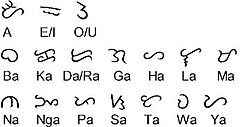Tagalog language
Tagalog[3] is one of the main or major local and regional languages in the Philippines, and it is "in practice" but not "according to the law" the basis, foundation or core of the current national language and one of the two official languages of the Philippines, which is named, declared, and called the Filipino language. More than 22 million people speak Tagalog as their first language.
| Tagalog | |
|---|---|
| Wikang Tagalog | |
| Native to | Philippines |
| Region | Katagalugan or Central to Southern Luzon; or in Metro Manila, Parts of Central Luzon, Most of Calabarzon, Parts of Mimaropa, and Northwestern Bicol |
| Ethnicity | Tagalog people |
| Native speakers | 28 million (2007)[1] 96% of the Philippines can speak Tagalog (2000)[2] |
| Language family | Austronesian
|
| Standard forms | Filipino
|
| Dialects | Bataan
Lubang
Marinduque
|
| Writing system | Latin (Abakada/Filipino); Baybayin (Revitalizing) |
| Official status | |
| Official language in | |
| Recognised minority language in | Philippines (as a regional language and an auxiliary official language in the predominantly Tagalog-speaking areas) |
| Regulated by | Commission on the Filipino Language |
| Language codes | |
| ISO 639-1 | tl |
| ISO 639-2 | tgl, fil |
| ISO 639-3 | tgl – inclusive code Individual code: fil – Filipino |
| Linguasphere | 31-CKA |
 Predominantly Tagalog-speaking regions in the Philippines. The color-schemes represent the 4 dialect zones of the language: Northern, Central, Southern, and Marinduque. In addition, Tagalog is used as a second language across the entire country, especially in the form of Filipino. | |
Tagalog was originally spoken by the Tagalog people in the Philippines, who were mainly in most of the central and southern parts of Luzon, the northern island chain of the Philippines.
Today, Tagalog is spoken nationwide and used by other Filipinos as a second language and by most Filipinos from different parts of the Philippines to understand one another.
The Filipino language is a language that continues to undergo evolution and development from the Pilipino language since 1987. It has more influences from the other languages of the Philippines and foreign languages than the core Tagalog language.
The Pilipino language since 1959 has been the final official name of the former or previous official and national language of the Philippines. It is one of the two official languages of the Philippines, with English being the other.
Filipino originally was used with an abugida writing system, Baybayin, but the Latin alphabet is now used, especially the former or previous abakada (type of alphabet), which ahd 25 letters and the current Filipino alphabet, which has 28 letters.
Sample phrases
- Magandang Umaga! - Good Morning!
- Magandang Gabi! - Good Evening!
- Magandang Tanghali! - Good Afternoon!
- Kumusta!/Kamusta? - How are you?/Hello! (Informal)
- May ______ ba kayo? - Do you have ______?(Formal)
- Mayroon po: Response to "May ______ ba kayo", meaning "Yes, sir".
- Wala po - Opposite of "Mayroon po".
- Kayo - you (formal), informally, it refers to "you all".
- Magkano ito? - How much is this?
- po: ma'am or sir (used in sentences to be polite to an elder speaker)
- Mabuhay! - Long Live
- Ako po si (Pangalan)... - I am (Name)...
- Mahal kita - I love you
- Nanay - Mom
- Tatay - Dad
- Hindi - No
- Bakit? - Why?
- Saan? - Where?
- Ano? - What?
- Kailan? - When?
- Sino? - Who?
Tagalog Language Media
A Tagalog speaker, recorded in South Africa.
The base consonants and vowels of the Baybayin script, the original writing system of Tagalog
Diariong Tagalog (Tagalog Newspaper), the first bilingual newspaper in the Philippines founded in 1882 written in both Tagalog and Spanish.
No dumping sign along the highway in the Laguna province, Philippines.
Welcome arch to Palayan, Nueva Ecija.
The Tagalog caption (bottom-left) about venom at the California Academy of Sciences in San Francisco includes words that are uncommonly used in Metro Manila such as "hungkag" (hollow), "sinisila" (prey), "mapanila" (predator), "tibò" (stinger), and "kabatiran" (clue/knowledge/discernment).
Related pages
References
- ↑ Nationalencyklopedin "Världens 100 största språk 2007" The World's 100 Largest Languages in 2007
- ↑ "Educational characteristics of the Filipinos". Census.gov.ph. 2005-03-18. Archived from the original on 2008-01-27. Retrieved 2012-06-07.
- ↑ English, Leo James (1990). "Tagalog, Pilipino". Tagalog-English Dictionary.
{{cite encyclopedia}}: Check date values in:|date=(help)
Other websites
| This language has its own Wikipedia project. See the Tagalog edition. |
 Tagalog at Wikibooks
Tagalog at Wikibooks Filipino phrasebook travel guide from Wikivoyage
Filipino phrasebook travel guide from Wikivoyage Media related to Tagalog language at Wikimedia Commons
Media related to Tagalog language at Wikimedia Commons








